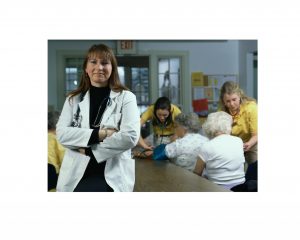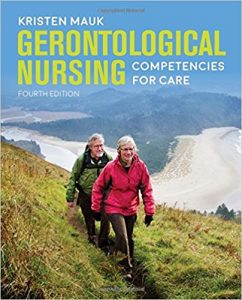Dr. Mauk’s Boomer Blog
Each week, Dr. Kristen Mauk shares thoughts relevant to Baby Boomers that are aimed to educate and amuse.
Dr. Kristen L. Mauk, PhD, DNP, RN, CRRN, GCNS-BC, GNP-BC, FAAN

Guest Blog: Hearing Loss and Dementia
Age related hearing loss is the most common form of hearing loss especially in the over 65s. While deteriorating hearing due to an aging system is an (unfortunate) natural process, factors such as family history of hearing loss, smoking, and certain medication, prolonged exposure to loud noise will have an impact on its rate of deterioration and resultant severity.
The human inner ear contains hair cells that help pick up information contained within sound waves. This information is then transmitted by way of the hearing nerve to the brain for further processing. As the body matures (or due to exposure to loud noise), hair cells can become damaged and/or die. The process can start as early as in a person’s 40s, but presents far more commonly in the over 65s and the over 70s. The body is unable to regenerate new hair cells, so there will eventually come a point when the person senses that their hearing isn’t what it used to be. (Although it is often friends and family members that notice the deterioration in hearing ability and alert the individual.)
There are common problems that the hard of hearing report; but how significant their impact on the person’s daily life will vary considerably across individuals.
Common symptoms include:
• Difficulty hearing people around you
• Frequently asking people to repeat themselves
• Frustration at not being able to hear
• Certain sounds seeming overly loud
• Problems hearing in noisy areas
• Problems telling apart certain sounds such as “s” or “th”
• More difficulty understanding people with higher-pitched voices
• Ringing in the ears
Loss of hearing and its likely cause can be established after attending a hearing test. The hearing exam or hearing test will cover a review of your medical history and a physical ear exam. If the hearing loss is age-related in nature, it is often managed through the use of hearing aids. There is no cure to undo the natural aging process that results in hair cell decline, so treatment should be viewed as a means to improve quality of life by managing the condition rather than curing it.
Those that willingly or unwillingly leave hearing loss unmanaged may face further longer term health complications, including depression, and perhaps surprisingly, cognitive and mental health decline.
There is a worrying link between hearing loss and dementia currently being explored. Recent research suggests that there is a connection between hearing loss and dementia. The hard of hearing are at a high risk of experiencing social isolation due to reduced communication with their immediate surroundings; and perhaps as a result of this, they are reportedly more likely to develop dementia.
An individual with hearing loss must concentrate harder to hear and often has to use lip reading and facial expressions to fill in the gaps as to what was said. After a while, this level of concentration can lead to fatigue and symptoms that mimic physical exhaustion. Some individuals may choose to simply avoid conversation, as it is too exhausting, thereby opening the door to social isolation.
If you have concerns about your hearing or the hearing of someone you care for, do arrange a simple and quick hearing test.
Information written by Joan McKechnie BSc Hons Audiology & Speech Pathology. Joan works for UK based Hearing Direct. In addition to her role as one of the company’s audiologists, Joan helps maintain an information blog on hearing loss.
Guest Blog: Cognitive Issues in Seniors: Everything You Need To Know
In essence, mild cognitive impairment (MCI) is a condition in which an individual experiences a slight decline in mental abilities. While minor, the decline can be easily noticed by the person concerned or the people they interact with. The changes, however, are not severe enough to interfere with their routine activities and daily life.
Decline Due to Normal Aging vs. Mild Cognitive Impairment: What the Difference?
Gradual cognitive decline is sometimes evident with healthy aging. For instance, the mental processing slows down, the ability to learn new information is reduced, and the likelihood of getting distracted increases.
However, decline brought about by normal aging will not affect overall functioning or the ability to perform routine activities. Normal aging will also not affect intelligence, recognition, or long-term memory.
In normal aging, older people may forget names (and words) and misplace things occasionally. However, with mild cognitive impairment, the person forgets information and conversations one would usually remember, such as planned events and other appointments.
Does MCI Always Lead to Dementia?
Dementia is the general term used to describe the severe decline in mental function that interferes with daily living. There are instances, where a treatable disease or illness causes MCI.
However, researchers also discovered that for most patients with MCI, it is considered the point along the pathway to dementia. MCI can be secondary to various illnesses, including Parkinson’s and Alzheimer’s disease, vascular dementia, and frontotemporal dementia.
Is MCI Common?
According to the American Academy of Neurology, MCI is present in about 8 percent of people aged 65 to 69, in 15 percent of people aged 75 to 79, in 25 percent of those aged 80 to 84, and in about 37 percent of people aged 85 years or older.
Conclusion
If you suspect you have MCI, it is recommended that you see your doctor right away. While there is no specific test that can confirm a diagnosis, your doctor can tell if you have MCI based on the symptoms that manifest and the information you will provide.
About the Author
Melissa Andrews is the Content Marketing Strategist for Paradise Living Centers, an assisted living center for seniors with locations in Paradise Valley and Phoenix, Arizona. In her spare time, she enjoys cooking and going on hiking trips with her siblings and cousins.
Be informed about Stroke
May is National Stroke Awareness month, so this is a good time to reflect on stroke prevention and treatment. Consider these facts about stroke from the American Stroke Association (2013): Be informed about stroke.
• Nearly 800,000 Americans annually suffer a new or recurrent stroke.
• A stroke occurs about once every 40 seconds. About every 4 minutes, someone dies of a stroke.
• Stroke is the 4th leading cause of death in the United States, killing more than 137,000 people a year.
• Risk of stroke death is higher for African American males and females than for whites. Females have a higher rate of death from stroke than males.
• In 2010, Americans paid about $73.7 billion for stroke-related medical costs and disability.

Stroke is simply defined as an interruption of the blood supply to the brain. It is most often caused by a clot that either originated in the brain or traveled from another part of the body. Warning signs of stroke include (National Stroke Association, 2013):
• Sudden weakness or paralysis, usually on one side of the body
• Sudden confusion, speaking or understanding
• Sudden changes in vision
• Sudden dizziness, incoordination, or trouble walking
• Sudden severe headache with no known cause
If you or someone you love experiences any of these symptoms, call 911 immediately. Do not delay. New medical treatments may be able to reverse the effects of stroke, but time is critical. Note the time that the symptoms started so that you can inform the medical professionals who are providing treatment.
The effects of stroke depend on the area of the brain that is damaged. Some common results of stroke are weakness or paralysis on one side of the body, difficulty walking or dressing oneself, aphasia, trouble eating or swallowing, bowel and bladder changes, cognitive changes such as memory problems, and emotional issues such as depression and mood swings. Stroke affects the entire family, so be sure to seek out resources and support in your community if a stroke has touched your family.
For stroke survivors, treatment in an acute rehabilitation facility with an interdisciplinary team approach is highly recommended and results in more positive outcomes. The rehabilitation team works together with the survivor and family to accomplish personal goals and achieve the highest level of function possible. Although some of the effects of stroke may be long-lasting or permanent, there is hope of continued progress and good quality of life after stroke.
Guest Blog: Five Jobs For Seniors That Will Combat Loneliness
While many seniors enjoy leaving the workforce and retiring after years of hard work, some find the transition a difficult and lonely experience, especially those who live alone or far away from family members. It can be hard to get used to filling up the days without work — and co-workers — to help pass the time, and at times it’s equally difficult to create new friendships.
While it can be daunting at first, taking on a new job is a great way to form new bonds and friendships, stay active, and keep living a fulfilling life after a big change. Here are five great jobs for seniors who want to fill their days with people and activity.
Dog-walking
Chances are there are dozens of pet owners nearby who are in dire need of a responsible caretaker for their pets. Rover.com can help you find jobs in your area and will set you up with pet owners for a meet-and-greet. Once you find the job that’s right for you, the site will even handle the financial end of things. And for extra cuddle time with a sweet creature, you can also sign up to be a pet sitter.
Greeter/Hospitality
Restaurants, hotels, and retail stores are just three businesses that require greeters and hospitality, and while the duties vary, this can be a wonderful job for active seniors. It allows you to work with people while maintaining flexible hours, and many stores offer an employee discount on some of their items.
Tour Guide
Museums, hotels, and historical buildings are a few of the businesses that require tour guides, and these will likely offer flexible hours while still giving you the chance to socialize.
Tutor/Music Teacher
If you have experience in education, art, or music, you might consider tutoring or teaching lessons. Check Craigslist.org for job posts and consider advertising your services on social media, or even on a flier at your local supermarket.
Going through such a huge life change can be difficult at first, but there are plenty of jobs available for seniors who need flexible schedules and want to keep loneliness at bay.
Jenny Wise is a stay-at-home mom and home educator. She and her husband decided to homeschool when their oldest was four years old. During their journey, they’ve expanded their family and have faced many challenges. But they’re happy to have overcome each one. Jenny writes about her family’s experiences and homeschool, in general, on her new blog, SpecialHomeEducator.com.
Guest Blog: Assisted Living Vs. In-home Care: Which Is Right For Your Senior?
Introduction
As our loved ones age, it’s natural to consider their long-term care options. Two popular choices are assisted living and in-home care. Both provide essential services, but they differ in several ways. Making the right decision can be challenging, but understanding the key differences between the two options is crucial.
Whittier assisted living offers both options, and selecting the right one depends on various factors, such as personal preferences, health conditions, and budget. In this article, we will explore the differences between assisted living and in-home care, so you can make an informed decision that ensures the comfort, safety, and well-being of your senior loved one.
Pros and Cons of Assisted Living for Seniors
Seniors who require some level of support with everyday activities can benefit significantly from assisted living, but there are also certain negatives to consider. The following are some benefits and drawbacks of assisted living:
Pros:
- Seniors in assisted living facilities can get care and assistance from qualified carers around-the-clock.
- Seniors can interact with other residents and participate in assisted living activities.
- Seniors may find it more convenient to live their everyday lives thanks to the usual provision of meals, housekeeping, and other services.
Cons:
- The expense of assisted living may not be covered by insurance or government programs.
- Seniors living in assisted living facilities could feel as though they are losing their freedom and simple control.
- Assisted living facilities may provide seniors less privacy than independent living in their own homes.
Overall, assisted living can be an excellent choice for senior citizens who require some help with daily tasks and desire to interact with other seniors. However, when making this choice, it’s crucial to consider the cost and loss of independence.
Would Your Senior Loved One Benefit More From In-Home Care?
In-home care is a popular option when thinking about care alternatives for your elderly loved one. Here are some explanations as to why it might be preferable:
- In-home care offers individualized care catered to your senior’s needs, ensuring they get the support and attention they need.
- Your senior loved one can continue to live in the familiarity and comfort of their own home, which can improve their mental and emotional health.
- Your senior may preserve their independence and autonomy with in-home care, allowing them to enjoy life on their terms.
- If your senior needs minor support with daily living activities, in-home care may be less expensive than assisted living.
Considering these elements, you may decide whether in-home care is a better choice for your elderly relative or friend, enabling them to get the care they require while maintaining their quality of life.
Evaluating Your Senior’s Needs
It’s critical to evaluate the individual needs of your elderly loved one before deciding on assisted living or in-home care.
- Elements to consider include mobility and capacity for daily tasks, including eating, dressing, and bathing.
- It’s vital to consider your senior’s social requests, remembering their requirement for organization and cooperation for bunch exercises.
- Their choice for autonomous or helped living, as well as the administration of their clinical issues and doctor-prescribed meds, are significant elements.
- It’s vital to assess monetary factors, like protection inclusion and clinical costs.
In-Home Thought versus Aided Residing: The Value of Cost Examination
Cost is an essential variable to consider while picking helped dwelling and in-home thought for seniors. The following justifies the importance of cost comparison:
- The monthly cost of assisted living can range from $3,500 to $10,000, while the hourly cost of in-home care is generally between $15 and $30.
- To make an informed decision, it’s crucial to assess the costs of both options and determine which fits within your budget.
- Assisted living may have hidden costs, such as upfront fees, meal plans, and additional services, which can significantly impact the overall cost of care.
- In-home care is more customizable, allowing you to pay only for the services your senior loved one needs, potentially resulting in lower costs.
- The care location can also affect the overall cost, as assisted living may be more expensive in certain areas.
Understanding the Level of Care Your Senior Needs
When choosing between assisted living and in-home care, it is essential to understand the level of care your senior requires.
- If your senior has advanced care needs, such as dementia or Alzheimer’s disease, they may require the specialized care and support provided by an assisted living facility.
- If your senior requires minimal ADL assistance, in-home care may be better.
Choosing Between Assisted Living and In-Home Care
When choosing between assisted living and in-home care, it’s essential to consider each option’s flexibility.
- In-home care allows seniors to remain in the comfort of their own homes and maintain their independence while still receiving necessary care.
- Assisted living provides a more structured environment with 24-hour care and access to various services and amenities.
- Consider the level of flexibility your senior loved one requires and your preferences and lifestyle.
Safety and Security
Safety and security are key considerations when it comes to caring for seniors.
- In-home care may require modifications to the home to ensure safety and accessibility, such as installing grab bars in the bathroom or ramps for wheelchair access.
- Assisted living facilities provide 24-hour supervision, emergency response systems, and secure environments to ensure the safety and well-being of residents.
- Consider the specific safety needs of your loved one, such as fall risks or wandering behaviors, and evaluate which option can provide the necessary support and security.
By prioritizing safety and security, you can ensure your senior loved one receives the care they need in a safe and comfortable environment.
Evaluating Your Options and Making an Informed Decision
Ultimately, finding the right fit for your senior loved one requires careful evaluation of all options.
- Research and visit potential facilities or in-home care providers to evaluate their services and amenities.
- Consider the costs, level of care, and flexibility of each option, as well as the specific needs and preferences of your loved one.
- Don’t hesitate to ask questions and seek advice from healthcare professionals, family members, or friends who have gone through a similar experience.
By evaluating your options and making an informed decision, you can ensure that your senior loved one receives the care and support they need to live a happy and healthy life.
Conclusion
In conclusion, deciding between assisted living and in-home care for your senior loved one can be difficult. It is essential to carefully consider their unique needs and preferences and the level of care and support they require. With the help of resources like Whittier assisted living, you can make an informed decision that supports your senior’s overall well-being and quality of life.





